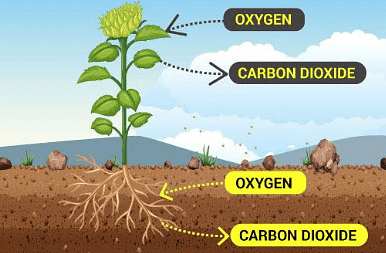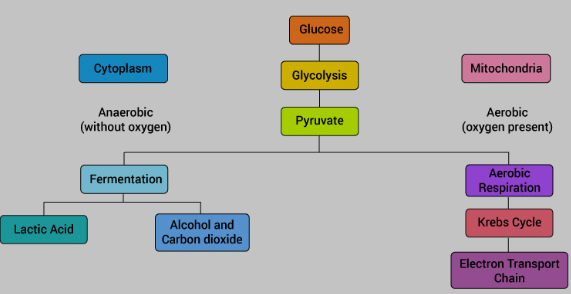Respiration in Organisms Class 7 Notes Science Chapter 6
| Table of contents |

|
| Respiratory System |

|
| Respiratory System in Animals |

|
| Respiratory System in Humans |

|
| Respiratory System in Plants |

|
| Aerobic and Anaerobic Respiration |

|
| Key Words |

|
All living organisms require oxygen to break down food and obtain energy. The respiratory system helps in the intake of air rich in oxygen and removal of air rich in carbon dioxide.
Respiratory System
The respiratory system is made up of a number of organs. It is found in all living organisms, but with varying levels of complexity.
 Breathing vs Respiration
Breathing vs RespirationBreathing is the process of inhaling air rich in oxygen and exhaling air rich in carbon dioxide. Respiration is the process of releasing energy from the breakdown of food.
Lists some differences between breathing and respiration.
Breathing
- It is a physical process of exchanging gases.
- No chemical reaction takes place.
- No enzymes or catalysts are involved.
- It takes place outside the cells.
- No energy is released during this process.
Respiration
- It is a series of chemical reactions that result in the release of energy.
- Enzymes and catalysts are involved.
- It takes place inside the cells.
- Energy is released during this process.
Respiratory Organs of Five Animals
- Fish: Gills
- Earthworm: Skin
- Cockroach: Spiracles and tracheae
- Humans: Lungs
- Birds: Lungs and air sacs
Respiratory System in Animals
The basic process of respiration is similar in all plants and animals and results in the release of energy. In unicellular animals, oxygen is directly absorbed from the water or air and carbon dioxide is released by diffusion. In higher animals, there are special organs that help in respiration.

- Respiration through skin
In animals such as earthworms and leeches, exchange of gases takes place through the moist and slimy surface of the skin. In amphibians such as frogs, newts, and salamanders, the exchange of gases takes place through the skin when in water and through the lungs when on land. - Respiration through air holes
In animals such as insects, there are several holes called spiracles in the body. Air enters an insect body through these spiracles and is carried through tubes called tracheal tubes. Oxygen is absorbed inside the body and carbon dioxide-rich air is sent out through these spiracles. - Respiration through gills
Most aquatic animals such as fish use special organs called gills for respiration. These gills are like slits and are made up of a large number of thread-like structures called filaments. These filaments are richly supplied with tiny blood vessels called capillaries. When water enters the body of the fish through the mouth, it flows over the gills. The blood in the capillaries absorbs oxygen from the water and gives out carbon dioxide. This oxygen is transported by the blood. - Respiration through lungs
Most mammals such as cats, dogs, monkeys, horses, human beings, etc., respire through special sac-like, spongy organs called lungs. Baby frogs (tadpoles) also breathe through gills, though they breathe through skin and lungs when they grow up to become frogs.
Respiratory System in Humans
The respiratory system is responsible for breathing in oxygen-rich air and breathing out carbon dioxide-rich air. The lungs, ribcage, and diaphragm are the primary components of the respiratory system.
- Passage of Air
The air enters the body through a pair of nostrils and passes through the nasal cavity. The larynx and trachea are then reached, followed by the bronchi and bronchioles. The alveoli are tiny airbags in the lungs where the exchange of gases takes place. Oxygen is absorbed into the blood, and carbon dioxide is released. - Exchange of Gases
Oxygen-rich air is absorbed into the blood and transported to all parts of the body, while carbon dioxide is picked up from the body and transported to the lungs. The oxygen combines with haemoglobin to form oxyhaemoglobin, which is carried to the cells. The oxygen released from oxyhaemoglobin helps in the breakdown of sugar to generate energy, carbon dioxide, water, and heat.
"Activity:
- As we inhale, air follows the route of nose, nasal cavity, larynx, trachea, bronchi, bronchioles, and alveoli.
- Oxygen is absorbed into the blood, and carbon dioxide is released.
- Carbon dioxide is transported by the blood to the lungs for exhalation.
- Oxygen combines with haemoglobin to form oxyhaemoglobin, which releases oxygen in the cells for energy generation."
Respiratory System in Plants
Respiration is a vital function in plants for breaking down starch to release energy. Plants respire through tiny holes or openings called stomata present on the underside of leaves.
 Stomata and gas exchange
Stomata and gas exchange- Stomata trap air containing gases like oxygen and carbon dioxide.
- The exchange of gases takes place inside plant cells.
- Carbon dioxide is used in photosynthesis to produce glucose, and oxygen is released into the atmosphere.
Root respiration
- Even roots buried in the soil require oxygen for the plant to survive.
- Plant roots typically take in oxygen from the small spaces between soil particles and release carbon dioxide.
- Proper root respiration is necessary for the plant to actively take up minerals from the soil.
- Farmers plough or till the soil to create tiny air spaces around soil particles for proper root respiration.
Aerobic and Anaerobic Respiration
Respiration is the process of breaking down food molecules to release energy. Respiration is primarily of two types: aerobic and anaerobic.

Aerobic Respiration
The process of respiration that takes place in the presence of oxygen is called aerobic respiration. Aerobic respiration results in the release of energy, and in the formation of carbon dioxide and water. Aerobic respiration is represented by the equation:
sugar + oxygen → energy + carbon dioxide + water.
Aerobic respiration is the most efficient form of respiration. The energy is given out gradually and in the form that can be used by the organism. The energy is stored inside the body in the form of ATP (adenosine triphosphate, energy-rich molecules), which can be used whenever needed.
Differences between Aerobic Respiration and Combustion
- Combustion is similar to the reaction involved in aerobic respiration, but there are some differences between the two.
- In combustion, energy is given out suddenly, in the form of heat or light.
- The energy is not stored as ATP, and cannot be used by the organism.
Anaerobic Respiration
- The process of respiration that takes place in the absence of oxygen is called anaerobic respiration.
- Anaerobic respiration results in the release of energy, and in the formation of carbon dioxide and ethyl alcohol (an organic compound).
- Anaerobic respiration is represented by the equation:
sugar → energy + carbon dioxide + ethyl alcohol. - Anaerobic respiration can be carried out only for a short period of time in humans.
- It occurs in our muscle cells when there is not enough oxygen supply, such as during heavy work or exercise, running fast, etc.
- Many microorganisms, such as yeast, bacteria, and fungi, can only respire anaerobically.
"Activity
Aim: To understand the process of respiration in organisms
Materials needed: Respirometer, germinating seeds, non-germinating seeds, cotton wool, potassium hydroxide, test tubes, rubber stoppers
Method: Set up a respirometer with germinating and non-germinating seeds, cotton wool, potassium hydroxide, and rubber stoppers. Record the readings after a certain time period.
Observation: The respirometer with germinating seeds shows a decrease in volume of air while the one with non-germinating seeds shows no change in volume of air.
Inference: Germinating seeds undergo respiration while non-germinating seeds do not.
Conclusion: Respiration is a vital process in organisms that helps in the production of energy.
Conclusion
- Recap of important points discussed in the chapter
- Importance of understanding respiration in organisms."
Key Words

|
139 videos|151 docs|18 tests
|















